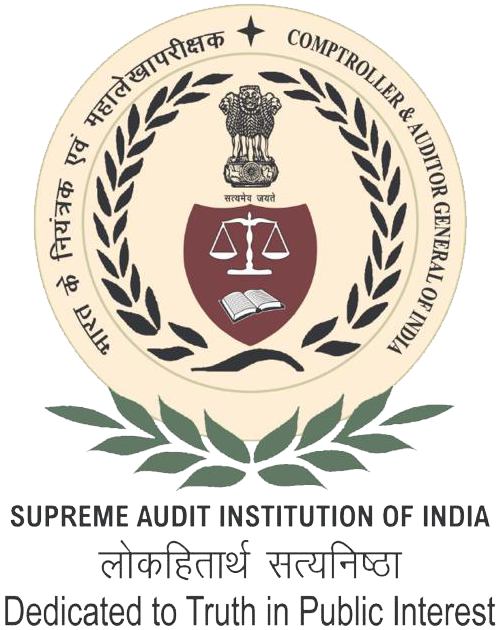Financial Audit
General
The purpose of an audit of financial statements is to enhance the degree of confidence of intended users in the financial statements. This is achieved through the expression of an opinion by the auditor as to whether the financial statements are prepared, in all material respects, in accordance with an applicable financial reporting framework, or — in the case of financial statements prepared in accordance with a fair presentation financial reporting framework — whether the financial statements are presented fairly, in all material respects, or give a true and fair view, in accordance with that framework.
Audit of financial statements of DPSUs by CAG
The audit of accounts of DPSUs, being Government companies, is conducted by this office by virtue of the provisions of Section 19 (1) of the CAG's (DPC) Act, 1971 as amended from time to time. These provisions specify that the related duties and powers shall be performed and exercised in accordance with the provisions of the Companies Act, 1956 replaced by the Companies Act, 2013.
In terms of Section 143(6) of the Companies Act, 2013, the CAG shall, within sixty days from the date of receipt of the Audit Report under Sub-section 5 of Section 143 have the right to conduct supplementary audit and comment upon or supplement such audit report. Section 143 (6) read with Section 136 enjoins on each company to place before its Annual General Meeting, the statutory auditor's audit report, together with the CAG's comments upon or supplement to it, in the prescribed manner.
Section 143(7) read with section 143(5) or Sub-section 7 of section 139 of the Companies Act, 2013 also empowers the CAG (and hence this office) to conduct a test audit of a Company's accounts.
The Companies Act, 2013 defines the term "Financial statements" to include the following:
- Balance Sheet as at the end of the financial year;
- Profit and Loss account for the financial year;
- Cash flow statement for the financial year;
- Statement of change in equity, if applicable, and
- Any explanatory note forming part of the above statements.
सामान्य
वित्तीय विवरणों के ऑडिट का उद्देश्य वित्तीय विवरणों में इच्छित उपयोगकर्ताओं के विश्वास की डिग्री को बढ़ाना है। यह लेखा परीक्षक द्वारा एक राय की अभिव्यक्ति के माध्यम से प्राप्त किया जाता है कि क्या वित्तीय विवरण सभी भौतिक मामलों में, एक लागू वित्तीय रिपोर्टिंग ढांचे के अनुसार तैयार किए गए हैं, या - एक निष्पक्ष प्रस्तुति के अनुसार तैयार किए गए वित्तीय विवरणों के मामले में वित्तीय रिपोर्टिंग ढांचा - क्या वित्तीय विवरण सभी भौतिक मामलों में निष्पक्ष रूप से प्रस्तुत किए जाते हैं, या उस ढांचे के अनुसार एक सही और निष्पक्ष दृष्टिकोण देते हैं।
सीएजी द्वारा डीपीएसयू के वित्तीय विवरणों की लेखापरीक्षा
डीपीएसयू, सरकारी कंपनियां होने के नाते, के खातों की लेखापरीक्षा, समय-समय पर संशोधित सीएजी (डीपीसी) अधिनियम, 1971 की धारा 19(1) के प्रावधानों के आधार पर इस कार्यालय द्वारा की जाती है। ये प्रावधान निर्दिष्ट करते हैं कि संबंधित कर्तव्यों और शक्तियों का प्रदर्शन और प्रयोग कंपनी अधिनियम, 1956 के प्रावधानों के अनुसार कंपनी अधिनियम, 2013 द्वारा प्रतिस्थापित किया जाएगा।
कंपनी अधिनियम, 2013 की धारा 143(6) के अनुसार, सीएजी को, धारा 143 की उप-धारा 5 के तहत लेखापरीक्षा रिपोर्ट प्राप्त होने की तारीख से साठ दिनों के भीतर पूरक लेखापरीक्षा करने और उस पर टिप्पणी करने का अधिकार होगा या ऐसी लेखापरीक्षा रिपोर्ट को पूरक करें। धारा 143 (6) के साथ पठित धारा 136 प्रत्येक कंपनी को अपनी वार्षिक आम बैठक, सांविधिक लेखापरीक्षक की लेखापरीक्षा रिपोर्ट, उस पर सीएजी की टिप्पणियों या उसके पूरक के साथ, निर्धारित तरीके से प्रस्तुत करने का निर्देश देती है।
कंपनी अधिनियम, 2013 की धारा 143(5) या धारा 139 की उप-धारा 7 के साथ पठित धारा 143(7) भी सीएजी (और इसलिए इस कार्यालय) को कंपनी के खातों का परीक्षण ऑडिट करने का अधिकार देती है।
कंपनी अधिनियम, 2013 निम्नलिखित को शामिल करने के लिए "वित्तीय विवरण" शब्द को परिभाषित करता है:
वित्तीय वर्ष के अंत में बैलेंस शीट;
वित्तीय वर्ष के लिए लाभ और हानि खाता;
वित्तीय वर्ष के लिए नकदी प्रवाह विवरण;
इक्विटी में परिवर्तन का विवरण, यदि लागू हो, और
उपरोक्त कथनों का हिस्सा बनने वाला कोई व्याख्यात्मक नोट।

